Engineers are worried that a new dust storm on Mars might put the three landers at risk when they arrive at the Red Planet in December and January. Right now, several small storms are combining to obscure part of the planet, but they could build to become a global storm – and event that’s happened several times in the past. The obscuring dust could limit the amount of electricity the landers can generate with their solar panels; flying dust could damage delicate equipment; and it could also heat up and expand the atmosphere, throwing the calculations off when the landers try to enter the atmosphere.
Potassium Could Be Heating the Earth’s Core
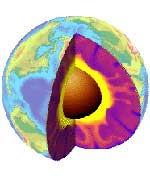
Image credit: NASA
Geologists at the University of Berkeley believe that radioactive potassium might be a substantial source of heat in the Earth’s core. The problem has been that scientists haven’t found as much potassium in the Earth’s crust as they would have expected from the Earth’s early bombardment period by asteroids. However, the geologists discovered that potassium can form a heavy alloy with iron under high temperatures and pressures, so it might have just sunk to the middle of the Earth, and could form a minute component of the core – but a fifth of its heat.
Radioactive potassium, common enough on Earth to make potassium-rich bananas one of the “hottest” foods around, appears also to be a substantial source of heat in the core of Earth, according to recent experiments by University of California, Berkeley, geophysicists.
Radioactive potassium, uranium and thorium are thought to be the three main sources of heat in the Earth’s interior, aside from that generated by the formation of the planet. Together, the heat keeps the mantle actively churning and the core generating a protective magnetic field.
But geophysicists have found much less potassium in the Earth’s crust and mantle than would be expected based on the composition of rocky meteors that supposedly formed the Earth. If, as some have proposed, the missing potassium resides in the Earth’s iron core, how did an element as light as potassium get there, especially since iron and potassium don’t mix?
Kanani Lee, who recently earned her Ph.D. from UC Berkeley, and UC Berkeley professor of earth and planetary science Raymond Jeanloz have discovered a possible answer. They’ve shown that at the high pressures and temperatures in the Earth’s interior, potassium can form an alloy with iron never before observed. During the planet’s formation, this potassium-iron alloy could have sunk to the core, depleting potassium in the overlying mantle and crust and providing a radioactive potassium heat source in addition to that supplied by uranium and thorium in the core.
Lee created the new alloy by squeezing iron and potassium between the tips of two diamonds to temperatures and pressures characteristic of 600-700 kilometers below the surface – 2,500 degrees Celsius and nearly 4 million pounds per square inch, or a quarter of a million times atmospheric pressure.
“Our new findings indicate that the core may contain as much as 1,200 parts per million potassium -just over one tenth of one percent,” Lee said. “This amount may seem small, and is comparable to the concentration of radioactive potassium naturally present in bananas. Combined over the entire mass of the Earth’s core, however, it can be enough to provide one-fifth of the heat given off by the Earth.”
Lee and Jeanloz will report their findings on Dec. 10, at the American Geophysical Union meeting in San Francisco, and in an article accepted for publication in Geophysical Research Letters.
“With one experiment, Lee and Jeanloz demonstrated that potassium may be an important heat source for the geodynamo, provided a way out of some troublesome aspects of the core’s thermal evolution, and further demonstrated that modern computational mineral physics not only complements experimental work, but that it can provide guidance to fruitful experimental explorations,” said Mark Bukowinski, professor of earth and planetary science at UC Berkeley, who predicted the unusual alloy in the mid-1970s.
Geophysicist Bruce Buffett of the University of Chicago cautions that more experiments need to be done to show that iron can actually pull potassium away from the silicate rocks that dominate in the Earth’s mantle.
“They proved it would be possible to dissolve potassium into liquid iron,” Buffet said. “Modelers need heat, so this is one source, because the radiogenic isotope of potassium can produce heat and that can help power convection in the core and drive the magnetic field. They proved it could go in. What’s important is how much is pulled out of the silicate. There’s still work to be done ”
If a significant amount of potassium does reside in the Earth’s core, this would clear up a lingering question – why the ratio of potassium to uranium in stony meteorites (chondrites), which presumably coalesced to form the Earth, is eight times greater than the observed ratio in the Earth’s crust. Though some geologists have asserted that the missing potassium resides in the core, there was no mechanism by which it could have reached the core. Other elements like oxygen and carbon form compounds or alloys with iron and presumably were dragged down by iron as it sank to the core. But at normal temperature and pressure, potassium does not associate with iron.
Others have argued that the missing potassium boiled away during the early, molten stage of Earth’s evolution.
The demonstration by Lee and Jeanloz that potassium can dissolve in iron to form an alloy provides an explanation for the missing potassium.
“Early in Earth’s history, the interior temperature and pressure would not have been high enough to make this alloy,” Lee said. “But as more and more meteorites piled on, the pressure and temperature would have increased to the point where this alloy could form.”
The existence of this high-pressure alloy was predicted by Bukowinski in the mid-1970s. Using quantum mechanical arguments, he suggested that high pressure would squeeze potassium’s lone outer electron into a lower shell, making the atom resemble iron and thus more likely to alloy with iron.
More recent quantum mechanical calculations using improved techniques, conducted with Gerd Steinle-Neumann at the Universit?t Bayreuth’s Bayerisches Geoinstit?t, confirmed the new experimental measurements.
“This really replicates and verifies the earlier calculations 26 years ago and provides a physical explanation for our experimental results,” Jeanloz said.
The Earth is thought to have formed from the collision of many rocky asteroids, perhaps hundreds of kilometers in diameter, in the early solar system. As the proto-Earth gradually bulked up, continuing asteroid collisions and gravitational collapse kept the planet molten. Heavier elements ? in particular iron – would have sunk to the core in 10 to 100 million years’ time, carrying with it other elements that bind to iron.
Gradually, however, the Earth would have cooled off and become a dead rocky globe with a cold iron ball at the core if not for the continued release of heat by the decay of radioactive elements like potassium-40, uranium-238 and thorium-232, which have half-lives of 1.25 billion, 4 billion and 14 billion years, respectively. About one in every thousand potassium atoms is radioactive.
The heat generated in the core turns the iron into a convecting dynamo that maintains a magnetic field strong enough to shield the planet from the solar wind. This heat leaks out into the mantle, causing convection in the rock that moves crustal plates and fuels volcanoes.
Balancing the heat generated in the core with the known concentrations of radiogenic isotopes has been difficult, however, and the missing potassium has been a big part of the problem. One researcher proposed earlier this year that sulfur could help potassium associate with iron and provide a means by which potassium could reach the core.
The experiment by Lee and Jeanloz shows that sulfur is not necessary. Lee combined pure iron and pure potassium in a diamond anvil cell and squeezed the small sample to 26 gigapascals of pressure while heating the sample with a laser above 2,500 Kelvin (4,000 degrees Fahrenheit), which is above the melting points of both potassium and iron. She conducted this experiment six times in the high-intensity X-ray beams of two different accelerators – Lawrence Berkeley National Laboratory’s Advanced Light Source and the Stanford Synchrotron Radiation Laboratory – to obtain X-ray diffraction images of the samples’ internal structure. The images confirmed that potassium and iron had mixed evenly to form an alloy, much as iron and carbon mix to form steel alloy.
In the theoretical magma ocean of a proto-Earth, the pressure at a depth of 400-1,000 kilometers (270-670 miles) would be between 15 and 35 gigapascals and the temperature would be 2,200-3,000 Kelvin, Jeanloz said.
“At these temperatures and pressures, the underlying physics changes and the electron density shifts, making potassium look more like iron,” Jeanloz said. “At high pressure, the periodic table looks totally different.”
“The work by Lee and Jeanloz provides the first proof that potassium is indeed miscible in iron at high pressures and, perhaps as significantly, it further vindicates the computational physics that underlies the original prediction,” Bukowinski said. “If it can be further demonstrated that potassium would enter iron in significant amounts in the presence of silicate minerals, conditions representative of likely core formation processes, then potassium could provide the extra heat needed to explain why the Earth’s inner core hasn’t frozen to as large a size as the thermal history of the core suggests it should.”
Jeanloz is excited by the fact that theoretical calculations are now not only explaining experimental findings at high pressure, but also predicting structures.
“We need theorists to identify interesting problems, not only check our results after the experiment,” he said. “That’s happening now. In the past half a dozen years, theorists have been making predictions that experimentalists are willing to spend a few years to demonstrate.”
The work was funded by the National Science Foundation and the Department of Energy.
Original Source: University of Berkeley News Release
Mars Gets an X-Ray
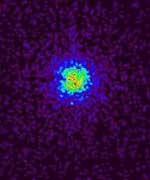
Image credit: ESA
The European Space Agency’s XMM-Newton X-Ray Observatory took this recent image of Mars in the x-ray spectrum. Every planet in the solar system, including the Earth, emits x-rays, but scientists aren’t completely sure why. One reason is thought to be “florescence emission”, when x-rays from the Sun hit atoms in our atmosphere and then get re-emitted with a characteristic signature. The bulk of the x-rays in the picture are coming from oxygen in the Martian atmosphere.
Another ESA mission is turning its gaze towards Mars. This recent image was taken by the X-ray observatory XMM-Newton.
All bodies in our Solar System, including planets such as Earth and Mars, emit X-ray radiation. As far as we know, there are several possible sources of this radiation.
One of the main sources is thought to be ?fluorescence emission?. X-rays from the Sun hit atoms of elements such as oxygen in the atmosphere of the planet, and this radiation is re-emitted as so-called ?characteristic? radiation which identifies those specific elements.
This image from XMM-Newton, recorded as part of a study by Dr K. Dennerl (Max Planck Institute for Extraterrestrial Physics, Garching, Germany) shows X-ray fluorescence emission from the atmosphere of Mars, mainly from oxygen. All of these emissions tell us something about the interaction of radiation with the planet’s atmosphere and its environment.
The study of Mars in X-ray wavelengths brings together the work of two very important ESA missions XMM-Newton and Mars Express. Both are crucial to our understanding of our nearest planetary neighbour, demonstrating the coherence of the ESA Science programme.
Original Source: ESA News Release
Book Review: Mars on Earth
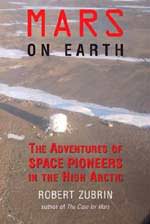
For more than three years, the Mars Society has maintained two research stations to test out what would be involved to send a human mission to Mars. In his latest book, Mars on Earth, Robert Zubrin reveals his journey to get the stations built (in the Canadian Arctic and the Utah desert), diary entries from living and working in the stations, and the experience he’s gained about what Martian explorers will go through when they first step foot on the Red Planet.
For more than three years, the Mars Society has maintained two research stations to test out what would be involved to send a human mission to Mars. In his latest book, Mars on Earth, Robert Zubrin reveals his journey to get the stations built (in the Canadian Arctic and the Utah desert), diary entries from living and working in the stations, and the experience he’s gained about what Martian explorers will go through when they first step foot on the Red Planet.
Robert Zubrin is best known for his earlier book, Case for Mars, where he laid out a revolutionary, and controversial, plan to send human explorers to Mars at a fraction of the cost proposed by NASA. I’ll make an admission right now; The Case for Mars was one of the most influential space exploration books I’ve ever read. Honestly, it rocked my world, so I was eager to catch up with Zubrin and see how the exploration of Mars was going. Another Zubrin book, Entering Space, is more future-looking and speculative, but equally entertaining.
After writing The Case for Mars, and learning of the tremendous amount of support for the concept of human exploration of Mars, Zubrin and some like-minded colleagues went on to found the Mars Society. Since they didn’t have a $50 billion to send a human mission to the Red Planet, the Mars Society has been bootstrapping their way there through a series of simulated Martian missions in two locations: remote Devon Island in the Canadian Arctic, which is one of the best analogs to Mars you can find on Earth; and a location in Utah which is less Mars-like, but offers nearly year-round accessibility. Mars on Earth is a chronicle of Zubrin’s journey from concept to completion of the two Mars research stations and the challenges faced on these first few steps on the way to exploration of the Red Planet.
The first, and largest, part of the book covers the events that led to the final construction of the research stations, and the majority of this is centered around the Flashline Arctic Mars Research Station on Devon Island in the Canadian Arctic. The theme to this part of the book is determination, ingenuity and thriftiness. The Society doesn’t have a lot of money, so they had to come up with clever solutions to overcome the inevitable challenges. Zubrin is a skilled writer, and very opinionated, so this part of the book was quite entertaining to read. During the construction of the station, some relationships were strained beyond their breaking point. Since it’s his book, Zubrin presents his point of view, but there are always two sides to every story. It would have interesting to hear the point of view from the other side of the conflicts. Maybe I’m being a little unrealistic.
The second part of the book consists of a series of status reports that Zubrin filed for the Mars Society and MSNBC while he was working at the two stations over several seasons of research and exploration. These are essentially diary entries covering daily activities on the station and various accomplishments. Since these are already available on the Internet, some readers will have already seen them. It’s nice to have them in one location, and Zubrin connects the reports together with additional information, but some people who followed the Society’s exploits on the Internet might feel a little cheated for content.
The final part of the book is the shortest, and it deals with the lessons he’s learned from his time in the research stations. When you consider the complexity of a human mission to Mars, where the explorers could be on the surface of the Red Planet for more than a year, there’s a mind boggling number of details to consider. If found it really interesting to see Zubrin’s conclusions after having tested some of this stuff out for real. What kind of rovers worked best; communications systems; how stuff broke down; the right role for robots; crew personalities? oh yeah, and bring a bread maker. This stuff is gold. If I had any complaint, it’s that it was too short. Either Zubrin doesn’t have the data gathered yet, or he didn’t want to bore people on which kind of canned meat people like better, but I find these kinds of “lessons learned” very entertaining. It can and should be a book all on its own – maybe a revised edition of The Case for Mars would do the trick.
All in all, I enjoyed Mars on Earth. Zubrin’s enthusiasm for the subject is infectious, and it was very entertaining to read the trials and tribulations he and his team had to overcome to build a little piece of Mars here on Earth.
More Information: Amazon.com – Amazon.ca – Amazon.co.uk
Florida Backs Away from Space Lottery Plans
After considering the possibility of giving away a flight to the International Space Station, Florida Lottery officials have decided people would probably just want the cash. The idea of a space lottery had been suggested by Space Adventures, an Arlington, VA company with a contract to sell two seats on upcoming Soyuz flights to the station. Florida Lottery officials didn’t reject the idea outright, but said that prize-based lotteries are never successful – even space enthusiasts would probably take $20 million in cash over a trip to space.
Russia Will Be Supplying Station Crews
Russian space officials confirmed this week that they will be delivering new crews to the International Space Station for at least the next year. Russia is planning to launch two missions to the station next year, with guaranteed spots for a Russian cosmonaut and American astronaut on each flight. A Soyuz in April will also carry an astronaut from the European Space Agency, but later flights could be available for tourist flights. Russia is considering five potential tourist candidates.
Cassini Collects Particles Accelerated by the Sun
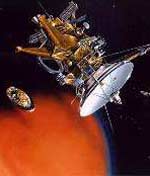
Image credit: NASA/JPL
NASA’s Saturn-bound spacecraft, Cassini, has made the first observation of interstellar pickup ions beyond the orbit of Jupiter. These are neutral particles in the solar system that get ionized when they get too close to the Sun, and then travel outwards with the solar wind. These ions have been seen near the Earth, but never out past the orbit of Jupiter. By measuring these particles, astronomers will have a better understanding of the low-density gas and dust that exists between the stars.
More than a year before the Cassini spacecraft arrives at Saturn, the Cassini Plasma Spectrometer (CAPS) has made the first in situ observations of interstellar pickup ions beyond the orbit of Jupiter. This is the first major discovery using data gathered by CAPS, destined to reach Saturn in July 2004.
Pickup ions are neutral particles in the solar system that become ionized near the Sun and join the solar wind, the supersonic stream of charged particles flowing out from the Sun. By observing these pickup ions, researchers can better understand the interstellar medium, the low-density gas and dust that fill the space between stars.
Astronomers have observed interstellar pickup ions as early as 1985 from a distance of 1 astronomical unit (AU, the distance from the Earth to the Sun), but never before have they seen pickup ions beyond 5 AU — Jupiter’s orbit. The CAPS team uploaded software that allowed the instrument to collect and transmit detections of the relatively rare pickup ions it encounters on its journey to Saturn.
During the observation period of October 2001 to February 2003 at distances of 6.4 to 8.2 AU, the instrument collected 2,627 samples. Analyses revealed that there is a strong depletion of hydrogen pickup ions compared to helium pickup ions in the region behind the Sun. The team determined that this newly observed depletion, or “interstellar hydrogen shadow,” is produced by radiation pressure and ionization of the neutrals. Most hydrogen atoms cannot penetrate into the downstream shadow region because they must pass near the Sun where they have a high probability of being ionized and swept out with the solar wind.
“These are very hard particles to measure because there are so few of them,” says Dr. David J. McComas, senior executive director of the SwRI Space Science and Engineering Division. “Previous models have included something like this interstellar hydrogen shadow, but these are the first direct measurements of it.”
Institute Scientist Dr. David T. Young is principal investigator of the CAPS instrument, the largest, most complex space plasma instrument flown to date, which will detect and analyze plasma (electrons and ions) found throughout the solar system. The overall mission of the Cassini spacecraft is to image the Saturn system at infrared, ultraviolet and visible wavelengths and to directly sample the dust, neutral and charged particle environment. Cassini also carries the Huygens probe, built by the European Space Agency, to study Saturn’s moon, Titan.
“This is certainly the first of many new discoveries to come by the Cassini spacecraft, and the Cassini Plasma Spectrometer in particular,” says McComas. “To have been able to make such an important contribution to heliospheric phenomenon on the way out to Saturn has been a great treat.”
SwRI also leads a feasibility study for the proposed Interstellar Boundary Explorer (IBEX) program, one of five candidates vying to fill two NASA mission slots. If selected, the program would launch a pair of energetic neutral atom cameras to directly image the interaction between the solar system and the interstellar medium – the region that the interstellar neutrals must flow through to enter the heliosphere.
The paper “The Interstellar Hydrogen Shadow: Observations of Interstellar Pickup Ions Beyond Jupiter,” is being presented December 9 at the American Geophysical Union (AGU) meeting in San Francisco and is in press in the Journal of Geophysical Research.
Original Source: SWRI News Release
Shuttle’s Wings Will Detect When They’re Damaged
NASA is planning to embed special sensors into the wings of the space shuttle fleet that will detect when they’ve been damaged – it was a foam strike like this that led to the destruction of Columbia nearly a year ago. A member of the safety oversight panel said that the sensors would be able to detect a hit, but not the extent of the damage, so astronauts would still need to spacewalk outside the shuttle to inspect it. Installing these sensors isn’t a requirement for the shuttle’s return to flight, but NASA believes it can have the work done by September 2004 – when the first shuttle is expected to lift off again.
New Doubts Over Dark Energy
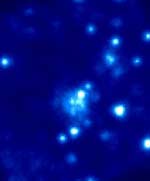
Image credit: ESA
It was only a few years ago that astronomers shook up current models of the Universe with the theory of dark energy; which says that the expansion of the Universe is actually accelerating. But new evidence gathered by the ESA’s XMM-Newton X-ray observatory has cast some doubt on the theory. By looking at distant galaxy clusters – up to 10 billion light-years away – the ESA astronomers found they contained more concentrated matter than the theory of dark energy would predict. If matter was so concentrated, the Universe can’t be 70% dark energy.
ESA’s X-ray observatory, XMM-Newton, has returned tantalising new data about the nature of the Universe. In a survey of distant clusters of galaxies, XMM-Newton has found puzzling differences between today’s clusters of galaxies and those present in the Universe around seven thousand million years ago. Some scientists claim that this can be interpreted to mean that the ‘dark energy’ which most astronomers now believe dominates the Universe simply does not exist?
Observations of eight distant clusters of galaxies, the furthest of which is around 10 thousand million light years away, were studied by an international group of astronomers led by David Lumb of ESA’s Space Research and Technology Centre (ESTEC) in the Netherlands. They compared these clusters to those found in the nearby Universe. This study was conducted as part of the larger XMM-Newton Omega Project, which investigates the density of matter in the Universe under the lead of Jim Bartlett of the College de France.
Clusters of galaxies are prodigious emitters of X-rays because they contain a large quantity of high-temperature gas. This gas surrounds galaxies in the same way as steam surrounds people in a sauna. By measuring the quantity and energy of X-rays from a cluster, astronomers can work out both the temperature of the cluster gas and also the mass of the cluster.
Theoretically, in a Universe where the density of matter is high, clusters of galaxies would continue to grow with time and so, on average, should contain more mass now than in the past.
Most astronomers believe that we live in a low-density Universe in which a mysterious substance known as ‘dark energy’ accounts for 70% of the content of the cosmos and, therefore, pervades everything. In this scenario, clusters of galaxies should stop growing early in the history of the Universe and look virtually indistinguishable from those of today.
In a paper soon to be published by the European journal Astronomy and Astrophysics, astronomers from the XMM-Newton Omega Project present results showing that clusters of galaxies in the distant Universe are not like those of today. They seem to give out more X-rays than today. So clearly, clusters of galaxies have changed their appearance with time.
In an accompanying paper, Alain Blanchard of the Laboratoire d’Astrophysique de l’Observatoire Midi-Pyr?n?es and his team use the results to calculate how the abundance of galaxy clusters changes with time. Blanchard says, “There were fewer galaxy clusters in the past.”
Such a result indicates that the Universe must be a high-density environment, in clear contradiction to the ‘concordance model,’ which postulates a Universe with up to 70% dark energy and a very low density of matter. Blanchard knows that this conclusion will be highly controversial, saying, “To account for these results you have to have a lot of matter in the Universe and that leaves little room for dark energy.”
To reconcile the new XMM-Newton observations with the concordance models, astronomers would have to admit a fundamental gap in their knowledge about the behaviour of the clusters and, possibly, of the galaxies within them. For instance, galaxies in the faraway clusters would have to be injecting more energy into their surrounding gas than is currently understood. That process should then gradually taper off as the cluster and the galaxies within it grow older.
No matter which way the results are interpreted, XMM-Newton has given astronomers a new insight into the Universe and a new mystery to puzzle over. As for the possibility that the XMM-Newton results are simply wrong, they are in the process of being confirmed by other X-ray observations. Should these return the same answer, we might have to rethink our understanding of the Universe.
The contents of the Universe
The content of the Universe is widely thought to consist of three types of substance: normal matter, dark matter and dark energy. Normal matter consists of the atoms that make up stars, planets, human beings and every other visible object in the Universe. As humbling as it sounds, normal matter almost certainly accounts for a small proportion of the Universe, somewhere between 1% and 10%.
The more astronomers observed the Universe, the more matter they needed to find to explain it all. This matter could not be made of normal atoms, however, otherwise there would be more stars and galaxies to be seen. Instead, they coined the term dark matter for this peculiar substance precisely because it escapes our detection. At the same time, physicists trying to further the understanding of the forces of nature were starting to believe that new and exotic particles of matter must be abundant in the Universe. These would hardly ever interact with normal matter and many now believe that these particles are the dark matter. At the present time, even though many experiments are underway to detect dark matter particles, none have been successful. Nevertheless, astronomers still believe that somewhere between 30% and 99% of the Universe may consist of dark matter.
Dark energy is the latest addition to the contents of the Universe. Originally, Albert Einstein introduced the idea of an all-pervading ‘cosmic energy’ before he knew that the Universe is expanding. The expanding Universe did not need a ‘cosmological constant’ as Einstein had called his energy. However, in the 1990s observations of exploding stars in the distant Universe suggested that the Universe was not just expanding but accelerating as well. The only way to explain this was to reintroduce Einstein’s cosmic energy in a slightly altered form, called dark energy. No one knows what the dark energy might be.
In the currently popular ‘concordance model’ of the Universe, 70% of the cosmos is thought to be dark energy, 25% dark matter and 5% normal matter.
Original Source: ESA News Release
Best Ultraviolet Image of Andromeda Galaxy
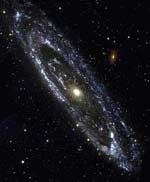
Image credit: NASA
NASA’s Galaxy Evolution Explorer (GALEX) has captured the most sensitive and comprehensive ultraviolet images ever taken of the Andromeda galaxy, M31. By studying the galaxy in the ultraviolet spectrum, astronomers can study some of the fundamental processes that lead the formation of new stars. A new collection of images included Andromeda, as well as the globular cluster M2, and the sky in the constellation of Bootes. GALEX was launched in April, 2003, and will map the sky in the ultraviolet spectrum, looking back to 10 billion years ago.
The most sensitive and comprehensive ultraviolet image ever taken of the Andromeda Galaxy, our nearest large neighbor galaxy, has been captured by NASA?s Galaxy Evolution Explorer. The image is one of several being released to the public as part of the mission?s first collection of pictures.
“The Andromeda image gives us a snapshot of the most recent star formation episode,” said Dr. Christopher Martin, Galaxy Evolution Explorer principal investigator and an astrophysics professor at the California Institute of Technology in Pasadena, which leads the mission. ?By studying this view of the galaxy in the process of forming stars, we can better understand how that fundamental process works, such as where stars form, how fast and why.?
The image of Andromeda, the most distant object the naked eye can see, is a mosaic of nine images taken in September and October of 2003. It combines two ultraviolet colors, one near ultraviolet (red) and one far ultraviolet (blue).
For comparison, a second image shows the Andromeda Galaxy, also called Messier 31, in visible light. Both images, along with other new pictures from the Galaxy Evolution Explorer, are available online at http://www.galex.caltech.edu and http://photojournal.jpl.nasa.gov/mission/GALEX . The new collection of images also includes views of several nearby galaxies; Stephan’s Quintet of Galaxies; an all-sky survey image of the globular star cluster M2; and a deep image of the sky in the constellation Bootes. The Galaxy Evolution Explorer team is also releasing the first batch of scientific data, so the science community can propose additional observations for the mission. These images and data display the power of the Galaxy Evolution Explorer to collect sensitive ultraviolet images of large parts of the sky.
“It?s very rewarding and exciting for the team to see the fruits of their labors,” said Kerry Erickson, the mission?s project manager at NASA?s Jet Propulsion Laboratory, Pasadena, Calif. ?Because people are accustomed to seeing objects in visible light, it?s amazing to see how different the universe looks in ultraviolet and how much information is revealed to us by those observations.?
Scientists are interested in learning more about the Andromeda galaxy, including its brightness, mass, age, and the distribution of young star clusters in its spiral arms. This will provide a tremendous amount of information about the mechanisms of star formation in galaxies, and will help them interpret ultraviolet and infrared observations of other, more distant galaxies.
The Galaxy Evolution Explorer launched on April 28, 2003. Its goal is to map the celestial sky in the ultraviolet and determine the history of star formation in the universe over the last 10 billion years. From its orbit high above Earth, the spacecraft will sweep the skies for up to 28 months using state-of-the-art ultraviolet detectors. Looking in the ultraviolet singles out galaxies dominated by young, hot, short-lived stars that give off a great deal energy at that wavelength. These galaxies are actively creating stars, and therefore provide a window into the history and causes of galactic star formation.
In addition to leading the mission, Caltech is also responsible for science operations and data analysis. JPL, a division of Caltech, manages the mission and led the science instrument development. The mission is part of NASA’s Explorers Program, managed by the Goddard Space Flight Center, Greenbelt, Md. The mission’s international partners are France and South Korea. Caltech manages JPL for NASA
Original Source: NASA News Release
